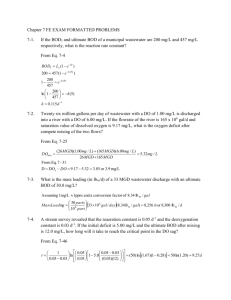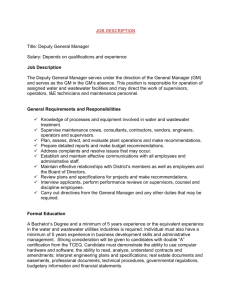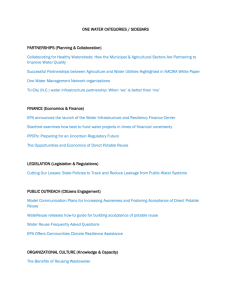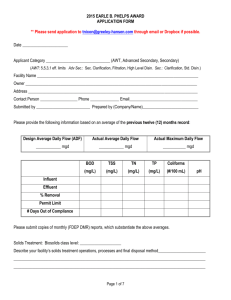A
advertisement
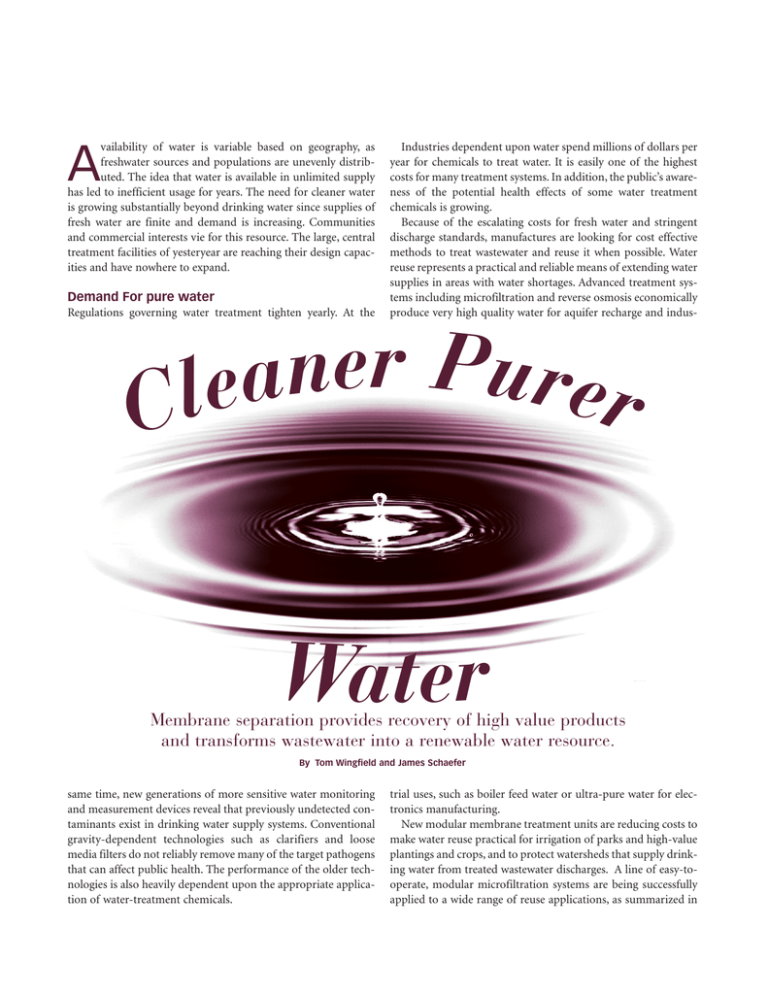
vailability of water is variable based on geography, as freshwater sources and populations are unevenly distributed. The idea that water is available in unlimited supply has led to inefficient usage for years. The need for cleaner water is growing substantially beyond drinking water since supplies of fresh water are finite and demand is increasing. Communities and commercial interests vie for this resource. The large, central treatment facilities of yesteryear are reaching their design capacities and have nowhere to expand. A Demand For pure water Regulations governing water treatment tighten yearly. At the Industries dependent upon water spend millions of dollars per year for chemicals to treat water. It is easily one of the highest costs for many treatment systems. In addition, the public’s awareness of the potential health effects of some water treatment chemicals is growing. Because of the escalating costs for fresh water and stringent discharge standards, manufactures are looking for cost effective methods to treat wastewater and reuse it when possible. Water reuse represents a practical and reliable means of extending water supplies in areas with water shortages. Advanced treatment systems including microfiltration and reverse osmosis economically produce very high quality water for aquifer recharge and indus- r P e u n r a e e l r C Water Membrane separation provides recovery of high value products and transforms wastewater into a renewable water resource. By Tom Wingfield and James Schaefer same time, new generations of more sensitive water monitoring and measurement devices reveal that previously undetected contaminants exist in drinking water supply systems. Conventional gravity-dependent technologies such as clarifiers and loose media filters do not reliably remove many of the target pathogens that can affect public health. The performance of the older technologies is also heavily dependent upon the appropriate application of water-treatment chemicals. trial uses, such as boiler feed water or ultra-pure water for electronics manufacturing. New modular membrane treatment units are reducing costs to make water reuse practical for irrigation of parks and high-value plantings and crops, and to protect watersheds that supply drinking water from treated wastewater discharges. A line of easy-tooperate, modular microfiltration systems are being successfully applied to a wide range of reuse applications, as summarized in Table 1: Selected water reuse installations Owner/Location Sonoma County Water Agency, Calif. Capacity 3 mgd Feed Water Secondary Effluent Reuse Application Irrigation Fountain Hills Sanitary District, Ariz. 2 mgd Tertiary Effluent Aquifer Recharge NYS Department of Corrections, Bedford Hills, N.Y. Toppan Electronics, San Diego, Calif. 1 mgd Secondary Effluent Discharge to Watershed 0.3 mgd Tertiary Effluent Process Water, Pre-RO City of Chandler, Ariz. 1.7 mgd Screened Wastewater Aquifer Recharge, Pre-RO System Description 4 MF racks 58 modules each 4 MF racks 48 modules each 3 X 40 module MF System 1 X 20 module MF System 4 MF racks 45 modules each table 1. Although pleated, backwashable microfiltration is a growing competitor to hollow fiber systems, the following discussion includes only examples with the hollow fiber technology platform. The Bedford Hills Correctional Facility and Toppan Electronics use small flow microfiltration units to meet tough water quality standards at low cost. The large installations for Fountain Hills Sanitary District and Sonoma County Water Agency, represent new applications for water reuse. It is designed to meet tough standards, provide flexibility and meet increasing water demands. United States. This microfiltration system was chosen because of its excellent turbidity removals, its ability to accept high chlorine residuals and the ability of the existing system to accept ultrafilter modules if the water must be disinfected without using chlorine. Feed turbidity ranges between 0.5 and 1.5 ntu, while the filtered turbidity is consistently 0.03 to 0.04 ntu. The extremely low turbidity improves ASR well longevity by minimizing the amount of solids pumped into the aquifer by the recharged water. A four train, 2 mgd system was designed such that expansion to 3 mgd involved only the addition of a fifth module rack and modules. Recycling water for wineries in Sonoma County Watershed and marine protection in New York Sonoma County, in the heart of California’s wine country, is reusing water to assure adequate supplies for drinking water, commercial, and agricultural uses. The 3-million gallon-per-day (mgd) water reuse facility treats secondary effluent from a partially aerated lagoon treatment plant near the county airport in Santa Rosa. The reused water will irrigate fields near the airport and some of the many nearby vineyards. In the future, reused water may also replenish water in local geysers, which have been less active recently because of low water levels. Microfiltration was chosen because it provides high quality filtered water with low suspended solids, which is required for vineyard irrigation. A detailed evaluation of capital and operating and maintenance (O&M) costs over a 20-year period showed that microfiltration, with its much lower O&M costs, was the most cost effective alternative. During the past five to 10 years, New York City has evaluated a number of different treatment technologies to reduce contamination of its drinking water reservoirs by municipal and industrial discharges in the region. Sub-micron microfiltration of secondary effluent was determined to be the best available technology to provide the level of water quality necessary for watershed protection. The first of many of these plants is at the Bedford Hills Correctional Facility in upstate New York. All along the East Coast from Maine to Chesapeake Bay, effluent from wastewater treatment, especially nutrients such as nitrogen and phosphorous damage marine fishing and shellfish industries. This ounce of prevention treatment method is dependent upon the controlled separation of contaminants inherent in a membrane treatment system. Not only is this measure serving to protect the public health, ecosystems and habitat, it is also preserving jobs and a way of life. In the heavily populated eastern seaboard, this high quality effluent is also becoming a valuable resource for industrial make up water and irrigation. Aquifer storage and recovery in Arizona The Fountain Hills Sanitary District 2 mgd microfiltration installation is part of a system for conjunctive use of groundwater. During the fall, winter and spring, the microfilter treats an average of 1.7 mgd of tertiary wastewater effluent, which is used to recharge the District’s three aquifer storage and recovery (ASR) wells. During the summer, tertiary effluent is used directly for golf course irrigation, and water is pumped from the ASR wells to meet peak water demands. This ASR system is one of only three similar installations in the Macroelectronics industry conserving water supplies in California Secondary wastewater effluent is a readily available source of water in water-short southern California. In San Diego, treated water replaces potable water purchased from the San Diego water system for Toppan Electronics Inc. An advanced microfiltration system treats 0.3 mgd of secondary wastewater effluent for reuse Figure 1 – 2 mgd Pall Microfiltration System at Fountain Hills Sanitary District. as process water. The new microfiltration equipment is a small flow system, providing consistently high removals of solids, pathogenic cysts, and bacteria from the secondary effluent and producing excellent feed water to Toppan’s existing reverse osmosis (RO) system. A growing body of data at this and other water reuse facilities demonstrates that microfiltration significantly improves RO system operation. Allowable fluxes increase by 20 percent, operating costs are reduced by 40 percent and the time interval between chemical cleanings for the RO system is extended by four times compared to the conventional means of lime settling and filtration of secondary effluent. The compact footprint of the microfiltration system allowed the 0.3 mgd unit to be installed in a small space outside a building and under a landing. The system’s simplified design allowed the units to fit through a standard 3-foot door at an existing facility. A low installed cost translates to a cost for reused water close to the cost of purchased potable water. It has been successfully operating since May 2000. Reuse using the system helps the environment by conserving precious supplies of potable water, while giving Toppan an economical water supply to keep operating even during droughts. Water reuse and economic development in Chandler, Arizona The City of Chandler, Ariz., has managed to attract several large semiconductor manufacturers to the Phoenix area by providing the infrastructure necessary for their growth. A large part of that is the Chandler Industrial Process Water Treatment Facility (IPWTF) where approximately 80 percent of the high quality reclaimed water is used to recharge the local aquifer. Another portion of that water is used for landscape irrigation and for makeup water to cooling towers. The manufacturer achieves a net water use of 1 mgd when contrasted with a residential development occupying the same land area, which would use approximately 2 mgd. An added benefit is that this conservation reduces the net load on city services. The IPWTF employs membrane filtration to achieve its goals. After initial pH adjustment of the raw wastewater from the manufacturing facility, the water passes through a microfilter prior to a filter cartridge enroute to a spiral wound reverse osmosis unit. Prior to the introduction of microfiltration into the process train, operating materials, such as replacement cartridge filters and treatment chemicals, ran $400,000 per year. A pre-RO microfiltration step resulted in a 40-percent improvement in operating effectiveness due to drastically reduced frequencies of changeouts, extended intervals between RO cleanings and longer life. Recycle and reuse water: membrane filtration a practical solution Water is a precious resource in limited supply whose use is subject to competition between industrial and municipal consumers. As a result, industry is looking for cost effective alternatives to recycle and reuse water. Membrane filtration is a viable option to transform wastewater into a reusable resource. Membrane systems are revolutionizing the way water is treated by providing industrial and municipal users with a greater degree of control over their water quality while lowering operating costs. Membranes are gaining acceptance for a wide range of applications including drinking water, process water and reclaiming water from wastewater. Membrane separation provides recovery of high value products and transforms wastewater into a renewable water resource. Excellent performance, reliability, and competitive economics make membrane systems a good solution for integrated water management applications. Water reuse is no longer a practice relegated to arid and semi arid regions of the country. Today, advanced treatment and reuse of wastewater can be found wherever competition for water use is high. PE For more information, contact Tom Wingfield, P.E., V.P. Pall Corporation at 516-801-9846 or James Schaefer, P.E., V.P. Pall Corporation at 516-801-9872. Reorder number: PE 9/02 Reprinted from Pollution Engineering, Copyright September 2002 Purifying intake water.Treating segregated process streams. Recycling wastewater. Manufacturers need their water to work hard to reduce water use and lower operating costs.To get more cycles from your water and to discover the widest range of energy-saving, cost efficient, rapid payback membrane water treatment systems call Pall Water Processing at 888.873.7255 (in NYS call 516.484.5400) or visit our web site at www.pall.com/thefutureofwater. recycling making water work harder

